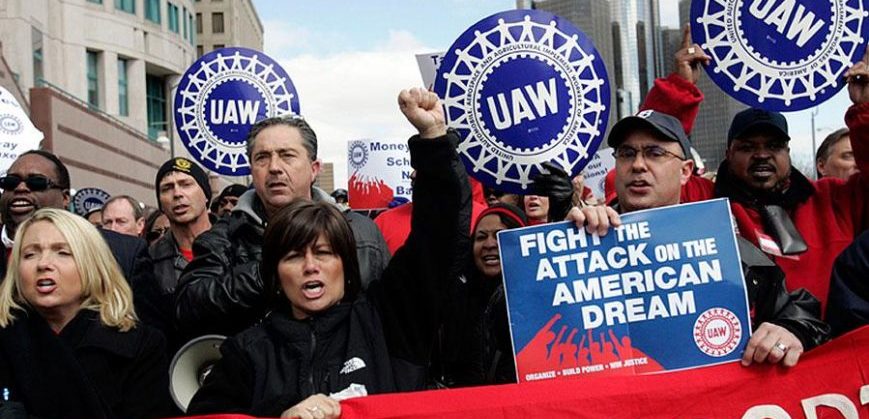Why America’s labor unions are about to die
by Raymond Hogler | November 30, 2016 12:01 PM
Endnotes:
- Raymond Hogler: https://theconversation.com/profiles/raymond-hogler-273136
- Colorado State University: http://theconversation.com/institutions/colorado-state-university-1267
- The Conversation: http://theconversation.com/
- list of participating faculty and researchers: https://theconversation.com/institutions/colorado-state-university
- written before: https://theconversation.com/how-labors-decline-opened-door-to-billionaire-trump-as-savior-of-american-workers-60689
- organized labor: https://theconversation.com/us/topics/labor-power-15530
- kept wages stagnant: https://theconversation.com/america-doesnt-just-need-a-raise-we-need-a-new-national-norm-for-wage-growth-46831
- income inequality: http://www.epi.org/publication/unions-decline-and-the-rise-of-the-top-10-percents-share-of-income/
- highest levels in over eight decades: https://eml.berkeley.edu/%7Esaez/saez-zucmanNBER14wealth.pdf
- Labor Reform Act of 1978: http://www.d.umn.edu/%7Eepeters5/MAPL5112/5112%20Articles/Fink-Labor%20Law%20Revisions%20and%20the%20End%20of%20Postwar%20Labor%20Accord.pdf
- institution most responsible: https://theconversation.com/the-rise-and-fall-of-us-labor-unions-and-why-they-still-matter-38263
- belong to unions: http://www.unionstats.com/
- social class basis: http://www.journals.uchicago.edu/doi/full/10.1086/684273
- Franklin Delano Roosevelt’s electoral victory in 1932: http://www.usnews.com/news/articles/2008/09/10/the-most-consequential-elections-in-history-franklin-delano-roosevelt-and-the-election-of-1932
- postmortem pundits: http://www.cnn.com/2016/11/10/politics/why-donald-trump-won/
- implement pro-labor decisions: https://www.littler.com/publication-press/publication/nlrb-issues-numerous-decisions-against-employers-hirozawas-term
- will have a smorgasbord of past cases and regulations: https://www.nlrb.gov/reports-guidance/rules-regulations
- rickety constitutional theory: http://thehill.com/blogs/pundits-blog/labor/256728-supreme-court-justices-at-work-bashing-unions
- Friedrichs v. California Teachers Association case: http://thehill.com/blogs/pundits-blog/labor/269488-right-to-work-takes-a-time-out-in-the-supreme-court
- a similar case is moving through: http://www.nrtw.org/blog/janus-v-afscme-update11212016/
- right-to-work laws: https://theconversation.com/the-misleading-arguments-propelling-right-to-work-laws-38265
- restoring incomes through innovation and deregulation: http://www.npr.org/2016/08/08/488816816/donald-trump-looks-to-turn-the-page-on-bad-week-with-economic-speech
- recent evidence shows: http://econweb.umd.edu/%7Edavis/eventpapers/ozbeklikright.pdf
- free-rider problem: https://theconversation.com/right-to-works-rapid-spread-is-creating-more-union-free-riders-38805
- legislative trifecta: https://ballotpedia.org/State_government_trifectas
- Republicans legislators said: http://www.joplinglobe.com/news/local_news/right-to-work-likely-coming-to-missouri/article_d20b0ad2-97af-5c6a-a6a4-c9bca440d3dc.html
- upheld the validity: http://abcnews.go.com/US/wireStory/appeals-court-upholds-local-work-law-kentucky-43646335
- first in New England: http://www.nationalreview.com/corner/442125/2016-election-results-right-work-wins
- declaring: http://www.cincinnati.com/story/opinion/contributors/2016/04/13/brinkman-unions-ultimate-zombies/82807378/
- national right-to-work bill: https://www.congress.gov/bill/114th-congress/house-bill/612
- I show in my book: http://www.abc-clio.com/ABC-CLIOCorporate/product.aspx?pc=A4410C
- article in Fortune: http://fortune.com/2016/11/09/trump-economy-taxes-immigration/
- The Conversation: http://theconversation.com
- original article: https://theconversation.com/why-americas-labor-unions-are-about-to-die-69575
Source URL: https://source.colostate.edu/americas-labor-unions-die/
Copyright ©2024 SOURCE unless otherwise noted.


